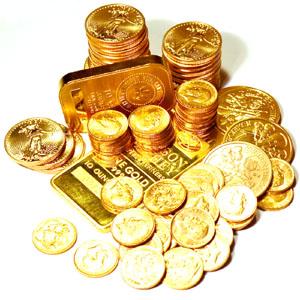The process of manufacturing gold coins is a complicated one. First an artist or artists will sketch the designs of the obverse and reverse sides of the gold coin. After the two sides are decided on, a master sculptor or master sculptors; engraves the two designs on two or more round plaster molds that are usually five times larger than the actual gold coin. This process is painstakingly long, the reason for this is the master sculptors must keep in mind the right depth and detail to make a well design gold coin. After the obverse and reverse sides are sculpted to perfection, the plaster molds are used to make a rubber resin mold. The rubber resin mold is then used to make an epoxy resin mold. Plaster is first used and then transferred to rubber because any mistakes on the plaster mold can be corrected by the master sculptors; these corrections are not practical to perform on the rubber molds.
Next the epoxy resin molds are mounted onto a pantograph. The pantograph traces the details of the epoxy resin molds onto master dies made of steel. The details of the master dies will be the same size of the actual gold coin. The steel master dies are then heated to a very high temperature and then rapidly cooled. The process of heating and then rapidly cooling the steel master dies makes it hard enough to strike gold coins. The diameters of the master dies are then shave down to the required size to strike gold coins. The master dies are then polish to perfection to be in an ample condition to strike the coins. Usually the master dies are used to make matrix dies; matrix dies are larger then the master dies and usually the same size of the original round plaster molds. The matrix dies are used with the pantograph to make duplicates of the master dies known as working dies. In most cases the master dies are used to help make working dies. The reason for this is dies after striking numerous coins starts to wear and must be replaced. The process of making master dies and working dies are similar in nature.
In the final process gold sheets are punch into circular blanks the same size of the gold coins to be struck. These blanks are then fed into an upsetting machine. The upsetting machine raises the rim of the blanks. A blank that is fed through an upsetting machine and have a raised rim is known as a planchet. Planchets are then polish using steel beads and water; after being polish each planchet weight is checked. The planchet is then struck with the polish working dies on the obverse and reverse sides with over one hundred tons of pressure. The working dies will have a negative image to make a positive imprint on the gold coins. The gold coins are then manually inspected for any imperfections. The gold coins that pass this inspection are then sold. The process of manufacturing gold coins is a complicated process; but it is this process that gives us the beautiful gold coins we have today.

Subscribe to:
Post Comments (Atom)
Blog Archive
-
▼
2009
(72)
-
▼
March
(19)
- How To Save Money When Buying Gold Coins And Bars
- The Benefits Of Saving In Gold
- What Kind Of Gold Bars To Buy
- Why Any Fiat Super Currency Is Doom To Fail
- Can Gold Confiscation Happen Again
- Can Gold Tarnish
- The Counterparty Risk Of Gold Compared To Other In...
- How Are Gold Bars Made
- Gold And Silver, The Differences When Investing
- Why All Fiat Currencies Eventually Become Worthless
- Buying Gold From A Dealer, Important Things To Know
- The Goal Of Investing In Gold
- The Price Of Gold, The Ways To Determine It
- Keeping Your Gold Safe From Theft And Confiscation
- How Are Gold Coins Made
- What Are Proof Gold Coins
- Gold And Financial Privacy
- How To Tell If Something Is Made Of Gold
- Gold And Fiat Currency
-
▼
March
(19)
No comments:
Post a Comment